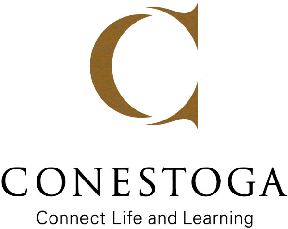
Intellectual Property Policy
- Approver:
- Academic Coordinating Committee
- Policy Owner:
- Vice President, Research
- Policy Lead(s):
- Research Data & Policy Analyst
- Effective date:
- 2013-03-01
- Date of last approval:
- 2025-02-26
- Status:
- Approved
Policy Statement
The purpose of this policy is to outline the governance of Intellectual Property (IP)
developed by employees and students of ÌÇÐÄvlog¾«Æ· Institute of Technology
and Advanced Learning (Conestoga).
Scope
This policy applies to students and Conestoga employees, including students working as paid employees of Conestoga. When students conduct work as part of paid employment with Conestoga they are treated as employees for the purposes of this policy.
This policy is in keeping with the IP provisions within applicable Conestoga collective
bargaining agreements. Should any part of this policy conflict with a collective
bargaining agreement, then the provisions of the collective bargaining agreement will
prevail. Similarly, if any part of this policy conflicts with a signed agreement between
any participating parties, the provisions of the signed agreement will prevail.
Definitions
ÌÇÐÄvlog¾«Æ· maintains a glossary of terms specific to the institution. The ones in use for this document are defined below.
- Background Intellectual Property
- Property and the legal right therein of either or both parties developed before the commencement of a project, including inventions, works, trademarks, integrated circuit topography, industrial design, trade secrets and any information embodying proprietary data such as technical data and computer software.
- Conestoga
- ‘Conestoga’ refers to The ÌÇÐÄvlog¾«Æ· Institute of Technology and Advanced Learning. Conestoga is a registered charity under the Canada Revenue Agency (CRA), with registered charitable number 106966799 RR 0001.
- Conestoga Employee
- Any employee of Conestoga, whether employed full-time, part-time, or on a contract basis, and includes, but is not limited to, faculty, student researchers when compensated as employees, research staff, support staff and administrators.
- Conestoga Resources
- Any funds administered by Conestoga, funds for employee compensation, materials, or facilities.
- Creator
- Any Conestoga employee and any student who makes, develops or creates any Intellectual Property (IP).
- Foreground Intellectual Property
- Any IP generated during research or a creative project. Also known as ‘arising IP’ or ‘resultant IP.’
- Intellectual Property
- Any form of knowledge or expression created by one’s intellect that can be legally protected and includes, but is not limited to:
- A Word, domain name, symbol, phrase, design, personal name, letter, numeral, colour, figurative element, three-dimensional shape, hologram, moving image, a mode of packaging goods, a sound, a scent, a taste, a texture and the positioning of any of the above - or combination of these used to distinguish goods or services of one person or organization from those of competitors (Trademarks).
- Inventions, processes, machines, articles of manufacture, compositions of matter, business methods, formulae, developments and improvements to any of the foregoing, whether patented or the subject of an application for patent and whether or not it is patentable, methods and processes for making any of the foregoing and related documentation (whether in written or electronic form) and know-how (Inventions).
- Software in source code or object code form, documentation, literary works, artistic works, pictorial works, graphic works, musical works, dramatic works, audiovisual works, performances, sound recordings and signals, including their content, and any compilations of any of them, whether registered or the subject of an application for registration, or capable of being registered, whether or not a copyright symbol appears on the material (Works).
- Three-dimensional configuration of the electronic circuits embodied in integrated circuit products or layout designs (Integrated Circuit Topographies).
- Features of shape, configuration, pattern or ornament (or any combination of these features) applied to a finished article made by hand, tool or machine (Industrial Design).
- Confidential information that has commercial value derived from its secrecy (Trade secrets).
- Intellectual Property Rights
- A property, by virtue of statute (an Act of Parliament or regulations enacted thereunder) or common law (based on precedents established in court cases), has certain rights associated with it. These rights exclude others from practicing or utilizing the IP. There are six main types of IP protection under Canadian law:
- Trademark rights: common law rights and statutory rights under The Trademarks Act of registered, pending applications for registration and rights to filed applications for Trademarks, including all rights of priority.
- Patents: A government grant, under the Patent Act, giving the right to exclude others from making, using or selling an invention.
- Copyrights: Exclusive rights to reproduce, copy, print, publish, perform, present, and communicate to the public original works, and sell copies of original Works, and convert or adapt one form of an original work into another, as stipulated in the Copyright Act.
- Integrated Circuit Topographies: the registration of a topography under the Integrated Circuits Topographies Act, unless shown to be invalid, gives the creator of the topography exclusive rights in the topography.
- Industrial design: Legal protection against making, importing, selling, renting or offering for sale an article (i.e., any thing that is made by hand, tool or machine) that is the same or substantially similar to an article whose shape, pattern, or ornament appeal to the eye, and that is protected by a registration under the Industrial Design Act.
- Trade secrets: common law (or civil law in Quebec) rights to enforce breaches of contract or confidence. All rights in licenses, sub-licenses, franchise agreements, waivers, and other contractual rights in any of the items listed in Section (a) - (f); and
- All rights to enforce the rights and obtain remedies for a violation of any of the rights listed in Sections (a) - (f).
- Partner
- Any third-party organization (including, but not limited to, a corporation, another academic institution, a research institution, a hospital or a government agency) that seeks to or does engage in a Research Project or grant activity with Conestoga.
- Research
- An undertaking intended to extend knowledge through a disciplined inquiry or systematic investigation.
- Student
- A person currently enrolled in studies at ÌÇÐÄvlog¾«Æ·, whether in a full-time, part-time or continuing education capacity.
Policy
- Intellectual Property Developed by Students
- IP created by a Conestoga student while engaging in academic activities (e.g., capstone projects, curriculum-based projects, etc.) is the property of the student.
- In the event the student working on a capstone project or curriculum-based project enters into an agreement with a partner before commencing the project, the ownership of IP arising from the collaboration shall be governed by the terms of the agreement. Conestoga is not a party to any negotiated agreements. Signed agreements will not limit the ability of a student to complete their academic requirements.
- Intellectual Property Developed by Conestoga Employees
- IP developed or authored by Conestoga employees within the scope of their employment or utilizing Conestoga resources, Conestoga proprietary information, data, material, Conestoga facilities, or that was commissioned by Conestoga, is the property of Conestoga unless a specific agreement is made to the contrary.
- When IP is developed on the initiative of a Conestoga employee outside the scope of their responsibilities at Conestoga and without the use of any Conestoga resources, Conestoga proprietary information, data, material, Conestoga facilities, or that was not commissioned by Conestoga, the IP is owned by the Conestoga employee.
- Where the IP bears a reasonable relationship to the employment responsibilities of a Conestoga employee, it will be the responsibility of the employee to show that the IP was developed entirely on their own initiative without the use of Conestoga resources, Conestoga proprietary information, data, material, Conestoga facilities, or that it was not commissioned by Conestoga.
- All Conestoga employee-developed IP with commercial potential should be disclosed by the Conestoga employee who created or authored that IP to the Conestoga Office of Research Services (ORS) in good faith and in a timely manner via the Intellectual Property Disclosure form found on the Researcher Portal. For guidance, consult with the ORS. This disclosure is not considered public disclosure. Disclosure must be made when it can be reasonably concluded that protectable subject matter has been created and sufficiently in advance of any public disclosure.
- Creators should be aware that public disclosure may result in loss of Intellectual Property Rights. This is especially true of Inventions, as a patent is difficult or impossible to obtain if public disclosure of the Invention has occurred. Care must therefore be taken to avoid premature public disclosure before a patent application has been filed.
- Conestoga employees must make all reasonable efforts to identify any employee-developed IP with commercial potential as early as possible and consult the ORS before making any public disclosure of such IP.
- Creators must also disclose to Conestoga any financial or other relationship that may affect the protection of such IP.
- Conestoga employees may utilize their professional methods and processes (e.g., a spreadsheet that calculates parameters for an equation, a method to evaluate the effectiveness of a clinical process) to investigate, resolve, or conduct research. These methods and processes are considered core knowledge and paramount to the work of the employee at Conestoga. Where the IP of such methods and processes is demonstrably owned by Conestoga or by Conestoga employees, then such items will not be defined as foreground or resulting IP from research or creative activities.
- Conestoga employees shall assist and execute any documentation which may be required by Conestoga to carry out the intent of this policy, including the execution of any assignment or consent agreements.
- Intellectual Property Pursuant to Third-Party Agreements
- Ownership of IP arising from collaborations with third parties shall be governed by the terms of an agreement, which is negotiated and executed in advance and will specify the ownership of background and foreground IP, the nature of ownership, method of protection of IP, payment of royalties or fees, and other terms as applicable.
- If a Conestoga employee does not disclose the use of their previously developed IP (i.e., background IP) within a project with a partner, the Conestoga employee may be in contradiction of a signed agreement with the partner.
- Transfer of Ownership
- If Conestoga chooses not to pursue a patent, license, or copyright in projects where it has IP rights, Conestoga may enter into an agreement with the creator of the IP under which the creator may apply for patent or copyright.
- For IP owned by Conestoga, Conestoga may elect to transfer ownership to a third-party for appropriate compensation.
- Any agreement with the creator of the IP will specify the rights of Conestoga and the rights of the creator related to ownership, term of ownership, royalties and fees, and the responsibilities of each party to apply for IP protection and to protect the IP. Such agreement must be duly executed in writing.
- Acknowledgement of Conestoga
- Conestoga should be acknowledged as a contributor to all IP developed using Conestoga resources.
- Dispute Resolution
- Any dispute on the interpretation of this policy will be submitted to the Vice President of Research (VPR) in writing. The VPR may elect to form a committee to investigate the dispute and recommend a resolution. The decision of the VPR is final and binding on all parties.
Relevant Legislation and Related Documents
Relevant legislation
Revision Log
‸¾²¹³Ù±ð | ‸¾±ð³Ù²¹¾±±ô²õ |
| ​2013-03-01 | ​First release of policy |
| ​2025-02-26 | ​Revisions to policy content. Academic Coordinating Committee – approved |
